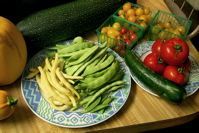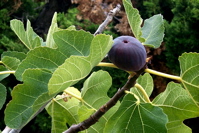This is the time of year when we take apart the garden and put it back together for winter gardening. We were so busy doing that, and getting sticky and dirty with sap, compost, mud, etc, that we forgot to take pictures! So I did catch-up pictures of the items left over, minus a couple of big stir-frys. This is the time of year when we have the funkiest-looking veggies, as we clear everything off the plant when we take it out of the garden.

As usual, we got a lovely return on our beans. I think beans are one of the great gifts to gardeners. I plant a couple of dozen beans of various types and harvest a quart of dried beans, plus eating several meals of fresh young whole beans. The plants themselves are great nitrogen fixers, and can be shredded and mulched in place on the garden beds at the end of the season, or composted.
This year we added Painted Lady to the runner bean collection, growing it separately on a carport support. The plants quickly climbed up to the roof, and were claimed delightedly by a couple of the local hummingbirds. The Painted Lady beans are white with black squiggles, in contrast to the pink and black Scarlet Runner beans. I've picked out a batch for next year's planting (and for sharing!), from the longest and best-formed pods. Here the harvested beans are drying a bit more on the shelf, along with previously harvested peppers.

Our melon experiments were much more successful this year than last. We also discovered that a local squirrel or rat likes melons (grr!). Despite losing a couple of melons, our mini-melons did very well in the self-watering planters. We got a couple of tiny yellow watermelons, some mini-charentais, and a couple of a variety I've forgotten. I think all of these were supposed to be larger. I don't know if our soil wasn't amended richly enough, or if the cold snaps in the summer did it. I skipped the usual midsummer composting, being away, and I feel that was a big mistake.

Yes, we're being cute here. Still, we find cardboard egg cartons to be a good place to store veggies that we don't like to refrigerate. They allow good air circulation and are handy. I'm thinking of finding some small wire baskets on drawer gliders and hanging them under my kitchen cabinets over the countertop, which would be less cluttery than the egg cartons, and would be safe from countertop spills. There were several Ichiban long purple eggplants in this carton, too, but they went into the frypan before the picture was taken. Really like the Ichiban and the Fairy Tale (shown here) for tenderness and no trace of bitterness.

I've left our big Early Girl tomato plant alone, but the Green Zebra is history, as is the Pineapple Beefsteak and the Persimmon, so we have plenty of green tomatoes ripening up. The startlingly dark one is the Purple Russian; they never got more than a pale pink outside before something four-footed harvested them, or we did in self-defense. I had great hopes for a complex, smoky flavor in this, as is supposed to be true of many black or dark tomatoes, but I found it actually rather bland. Purple Russian tomato won't be returning to my garden next year. I'll try Black Krim or Black Prince, and rig netting so that I'll have a chance of ripening them on the vine.
When you're picking green tomatoes for later ripening, especially if you're pulling out the plant, take a good chunk of stem along with them. The ripening tomatoes will pull sugars from the stem, which slowly withers and hardens. The resulting tomatoes are almost as sweet as vine-ripened, certainly far and away better than supermarket tomatoes, even hothouse ones.

Our plans for a bountiful potato harvest were dashed by the construction of new fence between our property and the neighbors' in the back, as we didn't find out it was coming in until the workmen were already there. They dug out my potato patch to put in a posthole, and I was only able to salvage the area where I'd laid down the standing plants straight out from the fence and covered them with dirt for an extended harvest. That led to a nice batch of small new potatoes, about half of which are pictured here. They were delicious! They are mostly Russian Banana, with a few Russets here and there.

A few larger potatoes survived the shovels of the fence-builders. They'll be chowder someday soon!
Labels: dry beans, drying, harvest snapshot, potatoes, tomatoes






















